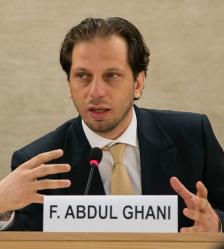Content from the Brookings Doha Center is now archived. In September 2021, after 14 years of impactful partnership, Brookings and the Brookings Doha Center announced that they were ending their affiliation. The Brookings Doha Center is now the Middle East Council on Global Affairs, a separate public policy institution based in Qatar.
Art is an effective means of advocacy for victims of mass suffering, such as those in Syria. This is why the Syrian Network for Human Rights (SNHR) has used visual art to seek truth and justice for Syria’s disappeared and tortured.
Art plays a crucial role in supporting the goals of transitional justice in Syria, particularly truth-seeking, accountability, and reconciliation. Few justice mechanisms are as effective as art as a means of engaging with an entire community. Public art around the world memorializes Syrian victims and embeds their names in the public psyche, reminding society of the sacrifices made by these individuals for the sake of a better future. In this way, art protects the legacy of victims and resists historical revisionism that aims to erase certain narratives about the past. Importantly, art also provides closure for survivors and their families, while publicly shaming those complicit in atrocities.
100 portraits: A sample of 100,000 forcibly disappeared Syrians
Since the onset of the Syrian conflict in 2011, approximately 100,000 Syrians have been forcibly disappeared. Yet, their plight is rarely foregrounded in the domestic, regional, or international public consciousness. The number of Syria’s disappeared is seen as just another statistic, in a world where statistics representing the massive human toll of the conflict have lost their shock value. Moreover, as the mass suffering mounts, the individual humanity of each disappeared Syrian fades.
To help reverse this trend, SNHR printed and published images of a selection of disappeared Syrian individuals. We selected these individuals by examining each of their backgrounds using data we had collected previously and by taking into account their histories of human rights activism. We also made sure that the selection was representative by selecting individuals from each Syrian governorate. Each image was printed with a brief thumbnail description detailing the date of arrest, the arresting party, and where the arrest took place.
For those involved in the popular anti-government movement, we drew their images, rather than simply printing their photographs. We decided to draw rather than print photographs because the act of drawing gives time, attention, and a special importance to the person being drawn. Photographs of disappeared individuals are very common; drawings, less so. Drawing portraits therefore makes them more striking to the general viewer, and serves as activism in and of itself.
SNHR’s Detainees Team, headed by Noor Alkhateb, worked with the Victims Department, headed by Hala Hisham, to select 50 cases from different Syrian governorates of women and men who had a prominent impact on their local communities, and who had been arrested and forcibly disappeared due to their activism in the movement for democratic change. The head of the Design Department, Aya Alsaman, then drew the portraits of the detainees. Cumulatively, this work took more than ten months.
Our target audiences include families of the disappeared, broader Syrian society, and the international community. SNHR printed the portraits and sent them to the families of the detained and disappeared. Many families expressed their appreciation for the portraits, but also their pain. Some used the images as profile pictures for their social media accounts on Facebook and Twitter in an effort to raise awareness and to seek the truth about the fate of their disappeared loved ones. The families’ positive response motivated us to complete the second phase of the art project by adding another 50 portraits, bringing the total to 100. We printed 40 of these portraits and exhibited them at a side event that took place at the United Nations General Assembly meeting in September 2019. The exhibit, titled “Justice and Accountability in Syria,” was sponsored by the United States, the United Kingdom, Germany, France, and the Netherlands. This exhibit helped humanize Syrian victims and draw attention to the Syrian cause at the international level.
Drawing methods of torture
Since 2011, SNHR has interviewed 115,000 torture survivors and used these testimonies to produce almost 100 reports about the brutal torture of detainees in detention and security centers. Instead of describing the practices in words, we decided to use art to illustrate the more than 70 methods of torture employed, showing their brutality and cruelty in graphic pictorial form. Our intended aim is to recognize the sacrifices of survivors of torture and their families, as well as to raise awareness in Syrian society and internationally. The use of art to illustrate torture methods is also an important advocacy strategy, calling on the international community to take action against these heinous practices. This was a mentally and emotionally exhausting project, but it was an important way to expose the truth of jailers’ actions toward those in captivity.
These drawings also serve as a public record—a sort of testimony to the horrific practices commonly used in prisons across Syria. They are an important source of public shaming for all who were, and remain, complicit in perpetrating these acts of torture. SNHR’s goal is to use this art to pursue accountability by pressuring international decision makers to seek justice for Syrian victims.
Ultimately, art is not a decisive factor in the pursuit of transitional justice in Syria. Rather, it reinforces the goals of other justice mechanisms. Action must follow activism. Nonetheless, SNHR’s projects demonstrate that art can effectively support the pillars of transitional justice by promoting truth, accountability, and reconciliation, as well as by bridging divides within Syrian society.




Commentary
Op-edPortraits of the disappeared: Art as advocacy in Syria
November 24, 2020